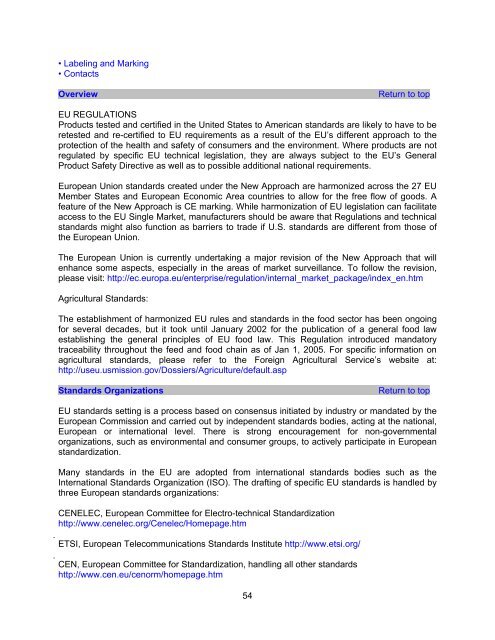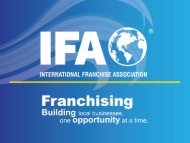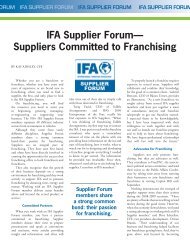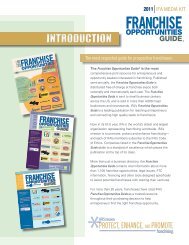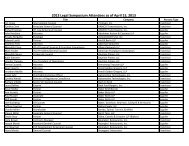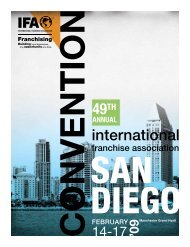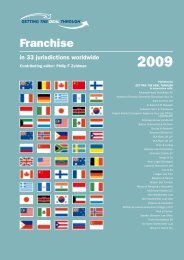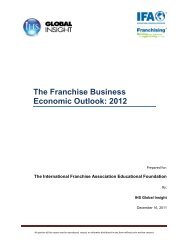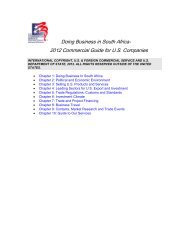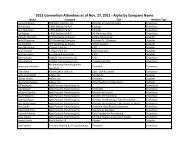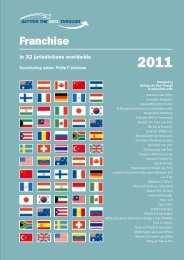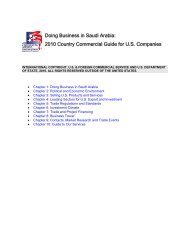Doing Business in Hungary 2010 - International Franchise Association
Doing Business in Hungary 2010 - International Franchise Association
Doing Business in Hungary 2010 - International Franchise Association
You also want an ePaper? Increase the reach of your titles
YUMPU automatically turns print PDFs into web optimized ePapers that Google loves.
• Label<strong>in</strong>g and Mark<strong>in</strong>g<br />
• Contacts<br />
Overview Return to top<br />
EU REGULATIONS<br />
Products tested and certified <strong>in</strong> the United States to American standards are likely to have to be<br />
retested and re-certified to EU requirements as a result of the EU’s different approach to the<br />
protection of the health and safety of consumers and the environment. Where products are not<br />
regulated by specific EU technical legislation, they are always subject to the EU’s General<br />
Product Safety Directive as well as to possible additional national requirements.<br />
European Union standards created under the New Approach are harmonized across the 27 EU<br />
Member States and European Economic Area countries to allow for the free flow of goods. A<br />
feature of the New Approach is CE mark<strong>in</strong>g. While harmonization of EU legislation can facilitate<br />
access to the EU S<strong>in</strong>gle Market, manufacturers should be aware that Regulations and technical<br />
standards might also function as barriers to trade if U.S. standards are different from those of<br />
the European Union.<br />
The European Union is currently undertak<strong>in</strong>g a major revision of the New Approach that will<br />
enhance some aspects, especially <strong>in</strong> the areas of market surveillance. To follow the revision,<br />
please visit: http://ec.europa.eu/enterprise/regulation/<strong>in</strong>ternal_market_package/<strong>in</strong>dex_en.htm<br />
Agricultural Standards:<br />
The establishment of harmonized EU rules and standards <strong>in</strong> the food sector has been ongo<strong>in</strong>g<br />
for several decades, but it took until January 2002 for the publication of a general food law<br />
establish<strong>in</strong>g the general pr<strong>in</strong>ciples of EU food law. This Regulation <strong>in</strong>troduced mandatory<br />
traceability throughout the feed and food cha<strong>in</strong> as of Jan 1, 2005. For specific <strong>in</strong>formation on<br />
agricultural standards, please refer to the Foreign Agricultural Service’s website at:<br />
http://useu.usmission.gov/Dossiers/Agriculture/default.asp<br />
Standards Organizations Return to top<br />
EU standards sett<strong>in</strong>g is a process based on consensus <strong>in</strong>itiated by <strong>in</strong>dustry or mandated by the<br />
European Commission and carried out by <strong>in</strong>dependent standards bodies, act<strong>in</strong>g at the national,<br />
European or <strong>in</strong>ternational level. There is strong encouragement for non-governmental<br />
organizations, such as environmental and consumer groups, to actively participate <strong>in</strong> European<br />
standardization.<br />
Many standards <strong>in</strong> the EU are adopted from <strong>in</strong>ternational standards bodies such as the<br />
<strong>International</strong> Standards Organization (ISO). The draft<strong>in</strong>g of specific EU standards is handled by<br />
three European standards organizations:<br />
CENELEC, European Committee for Electro-technical Standardization<br />
http://www.cenelec.org/Cenelec/Homepage.htm<br />
<br />
ETSI, European Telecommunications Standards Institute http://www.etsi.org/<br />
<br />
CEN, European Committee for Standardization, handl<strong>in</strong>g all other standards<br />
http://www.cen.eu/cenorm/homepage.htm<br />
54


